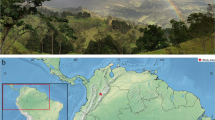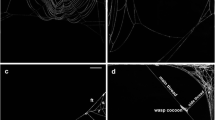Abstract
Some ichneumonid wasps of the Polysphincta group of genera (Hymenoptera: Ichneumonidae: Pimplinae) induce behavioral modifications in their host spiders during a specific moment of their development, resulting in the construction of webs that differ in several aspects from those constructed by unparasitized individuals. In this study, we describe the parasitoid wasp Hymenoepimecis pinheirensis sp. n. (Ichneumonidae: Pimplinae) and present information on behavioral modifications in the orb-web structure of its host, the spider Leucauge volupis (Keyserling 1893). Previously, reported observation on this host/parasitoid interaction was restricted to one locality, and the wasp species was misidentified as Hymenoepimecis jordanensis Loffredo and Penteado-Dias 2009. Modified webs built by parasitized spiders lack adhesive spirals and have several radii that converge to the web hub. The cocoon built by the wasp larvae is attached to the web hub, suspended by horizontal radial lines, and surrounded by a tridimensional tangle positioned below the hub. This modified web structure is similar to the most frequent architecture of webs constructed by individuals of Leucauge mariana (Taczanowski 1881) parasitized by Hymenoepimecis tedfordi Gauld 1991. However, cocoon webs built by L. volupis parasitized by H. pinheirensis sp. n. differ from the cocoon webs described for the other Leucauge species parasitized by Hymenoepimecis wasps. This evidence suggests that the modified web pattern in Leucauge species is determined by specific responses of each spider species to the behavioral manipulation mechanism displayed by the wasps.


Similar content being viewed by others
References
Barrantes G, Segura-Hernández L, Solano-Brenes D, Hanson P (2018) When a little is enough: cocoon web of Kapogea cyrtophoroides (Araneae: Araneidae) induced by Hymenoepimecis heidyae (Ichneumonidae: Pimplinae). Arachnol Mitt 55:30–35. https://doi.org/10.30963/aramit5505
Biron DG, Marché L, Ponton F, Loxdale HD, Galéotti N, Renault L, Joly C, Thomas F (2005) Behavioural manipulation in a grasshopper harbouring hairworm: a proteomics approach. Proc Biol Sci 272:2117–2126. https://doi.org/10.1098/rspb.2005.3213
Broad GR, Shaw MR, Fitton MG (2018) Ichneumonid wasps (Hymenoptera: Ichneumonoidea): their classification and biology. RES Handbooks for the Identification of British Insects, 7 (12). Field Studies Council, Shrewsbury, p 418
Dawkins R (1982) The extended phenotype. WH Freeman, Oxford, UK, p 336
Eberhard WG (1976) Photography of orb webs in the field. Bull Br Arachnol Soc 3:200–204
Eberhard WG (2000) The natural history and behavior of Hymenoepimecis argyraphaga (Hymenoptera: Ichneumonidae) a parasitoid of Plesiometa argyra (Araneae, Tetragnathidae). J Hymenopt Res 9:220–240
Eberhard WG (2013) The polysphinctine wasps Acrotaphus tibialis, Eruga ca. gutfreundi, and Hymenoepimecis tedfordi (Hymenoptera, Ichneumonidae, Pimplinae) induce their host spiders to build modified webs. Ann Entomol Soc Am 106:652–660. https://doi.org/10.1603/AN12147
Eberhard WG, Gonzaga MO (2019) Evidence that Polysphincta-group wasps (Hymenoptera: Ichneumonidae) use ecdysteroids to manipulate the web-construction behavior of their spider hosts. Biol J Linn Soc 127:429–471. https://doi.org/10.1093/biolinnean/blz044
Gadallah NS, El-Hennawy HK (2017) First record of the genus Oxyrrhexis Forster, 1869 (Hymenoptera: Ichneumonidae: Pimplinae, Ephialtini) for the fauna of Egypt, with an unexpected new host record. Zootaxa 4318:187–194. https://doi.org/10.11646/zootaxa.4318.1.11
Gauld ID (1991) The Ichneumonidae of Costa Rica I. Mem Am Entomol Inst 47:1–589
Gauld ID, Dubois J (2006) Phylogeny of the Polysphincta group of genera (Hymenoptera: Ichneumonidae; Pimplinae): a taxonomic revision of spider ectoparasitoids. Syst Entomol 31:529–564. https://doi.org/10.1111/j.1365-3113.2006.00334.x
Gonzaga MO, Kloss TG, Sobczak JF (2017) Host behavioural manipulation of spiders by Ichneumonid wasps. In: Viera C, Gonzaga MO (eds) Behaviour and ecology of spiders: contributions from the Neotropical region. Springer International Publishing AG 417–437. https://doi.org/10.1007/978-3-319-65717-2_16
Gonzaga MO, Moura RR, Pêgo PT, Bang DL, Meira FA (2015) Changes to web architecture of Leucauge volupis (Araneae: Tetragnathidae) induced by the parasitoid Hymenoepimecis jordanensis (Hymenoptera: Ichneumonidae). Behaviour 152:181–193. https://doi.org/10.1163/1568539X-00003238
Gonzaga MO, Pádua DG, Quero A (2022) Inclusion of an alien species in the host range of the Neotropical parasitoid Hymenoepimecis bicolor (Brullé, 1846) (Hymenoptera, Ichneumonidae). J Hymenopt Res 89:9–18. https://doi.org/10.3897/jhr.89.76620
Gonzaga MO, Sobczak JF (2007) Parasitoid-induced mortality of Araneus omnicolor (Araneae, Araneidae) by Hymenoepimecis sp. (Hymenoptera, Ichneumonidae) in southeastern Brazil. Naturwissenschaften 94:223–227. https://doi.org/10.1007/s00114-006-0177-z
Gonzaga MO, Sobczak JF, Penteado-Dias AM, Eberhard W (2010) Modification of Nephila clavipes (Araneae Nephilidae) webs induced by the parasitoids Hymenoepimecis bicolor and H. robertsae (Hymenoptera, Ichneumonidae). Ethol Ecol Evol 22:151–165. https://doi.org/10.1080/03949371003707836
Higgins L (1992) Developmental changes in barrier web structure under different levels of predation risk in Nephila clavipes (Araneae: Tetragnathidae). J Insect Behav 5:635–654. https://doi.org/10.1007/BF01048010
Hughes DP, Libersat F (2018) Neuroparasitology of parasite–insect associations. Annu Rev Entomol 63:471–487. https://doi.org/10.1146/annurev-ento-020117-043234
Kawada R, Buffington ML (2016) A scalable and modular dome illumination system for scientific microphotography on a budget. PLoSOne 11:e0153426. https://doi.org/10.1371/journal.pone.0153426
Kloss TG, Gonzaga MO, Oliveira LL, Sperber CF (2017) Proximate mechanism of behavioral manipulation of an orb-weaver spider host by a parasitoid wasp. PLoSOne 12:e0171336. https://doi.org/10.1371/journal.pone.0171336
Kloss TG, Gonzaga MO, Rouxinol JAM, Sperber CF (2016) Host behavioural manipulation of two orb-weaver spiders by parasitoid wasps. Anim Behav 111:289–296. https://doi.org/10.1016/j.anbehav.2015.11.001
Lafferty KD, Shaw JC (2013) Comparing mechanisms of host manipulation across host and parasite taxa. J Exp Biol 216:56–66. https://doi.org/10.1242/jeb.073668
Loffredo APS, Penteado-Dias AM (2009) New species of Hymenoepimecis Viereck (Hymenoptera, Ichneumonidae, Pimplinae) from Brazilian Atlantic forest. Rev Bras Entomol 53:11–14. https://doi.org/10.1590/S0085-56262009000100004
Matsumoto R (2016) Molecular phylogeny and systematics of the Polysphincta group of genera (Hymenoptera, Ichneumonidae, Pimplinae). Syst Entomol 4:1–13. https://doi.org/10.1111/syen.12196
Messas YF, Sobczak JF, Vasconcellos-Neto J (2017) An alternative host of Hymenoepimecis japi (Hymenoptera, Ichneumonidae) on a novel family (Araneae, Araneidae), with notes on behavioral manipulations. J Hymenopt Res 60:111–118. https://doi.org/10.3897/jhr.60.14817
Pádua DG (2022) First record of the Darwin wasp Hymenoepimecis Viereck, 1912 (Hymenoptera: Ichneumonidae: Pimplinae) from Argentina and Bolivia, with description of a new species. Zootaxa 5169:49–60. https://doi.org/10.11646/zootaxa.5169.1.4
Pádua DG, Kloss TG, Tavares MT et al (2022) Hyperparasitoids of polysphinctine Darwin wasps (Hymenoptera: Ichneumonidae: Pimplinae) in South America. Austral Entomol 61:170–186. https://doi.org/10.1111/aen.12593
Pádua DG, Oliveira ML, Onody HC (2015) The Brazilian Amazonian species of Hymenoepimecis Viereck, 1912 (Hymenoptera: Ichneumonidae: Pimplinae). Zootaxa 4058:175–194. https://doi.org/10.11646/zootaxa.4058.2.2
Pádua DG, Sääksjärvi IE, Monteiro RF, Oliveira ML (2020) Seven new species of spider-attacking Hymenoepimecis Viereck (Hymenoptera, Ichneumonidae, Pimplinae) from Ecuador, French Guiana, and Peru, with an identification key to the world species. ZooKeys 935:57–92. https://doi.org/10.3897/zookeys.935.50492
Pádua DG, Salvatierra L, Sobczak JF, Oliveira ML (2016) Parasitism of Hymenoepimecis manauara Pádua & Oliveira (Hymenoptera: Ichneumonidae: Pimplinae) on Leucauge henryi Mello-Leitão (Araneae: Tetragnathidae) in Brazilian Amazonian. Biodivers Data J 4:e11219. https://doi.org/10.3897/BDJ.4.e11219
Poulin R (2010) Parasite manipulation of host behavior: an update and frequently asked questions. In: Brockmann HJ, Roper TJ, Naguib M et al (eds) Advances in the study of behavior. Academic Press, pp 151–186. https://doi.org/10.1016/S0065-3454(10)41005-0
Poulin R, Randhawa HS (2015) Evolution of parasitism along convergent lines: from ecology to genomics. Parasitology 142(S1):S6–S15. https://doi.org/10.1017/S0031182013001674
Robinson MH, Robinson BC (1973) The stabilimenta of Nephila clavipes and the origins of stabilimentum-building in araneids. Psyche 80:277–288. https://doi.org/10.1155/1973/86980
Snodgrass RE (1941) The male genitalia of Hymenoptera. Smithson Misc Collect 99:1–86
Sobczak JF, Loffredo AP, Penteado-Dias AM, Gonzaga MO (2009) Two new species of Hymenoepimecis (Hymenoptera: Ichneumonidae: Pimplinae) with notes on their spider hosts and behavior manipulation. J Nat Hist 43:2691–2699. https://doi.org/10.1080/00222930903244010
Sobczak JF, Loffredo APS, Carmago LF, Penteado-Dias AM (2012a) Hymenoepimecis neotropica (Brues & Richardson) (Hymenoptera, Ichneumonidae, Pimplinae) parasitoid of Araneus omnicolor (Keyserling) (Araneae, Araneidae): first host record and new occurrence to Brazil. Rev Bras Entomol 56:390–392. https://doi.org/10.1590/S0085-56262012005000055
Sobczak JF, Loffredo APS, Penteado-Dias AM (2012b) Parasitism on Araneus venatrix (Koch, 1838) (Araneae: Araneidae) by Hymenoepimecis silvanae Loffredo and Penteado-Dias, 2009 (Ichneumonidae, Pimplinae) with description of male of the wasp. Braz J Biol 72:221–223. https://doi.org/10.1590/S1519-69842012000100028
Sobczak JF, Sobczak JCMSM, Messas YF (2014) A new record of a host-parasitoid interaction: Hymenoepimecis veranii Lofredo & Penteado-Dias, 2009 (Hymenoptera: Ichneumonidae) parasitizing Araneus orgaos Levi, 1991 (Araneae: Araneidae). J Insect Behav 27:753–758. https://doi.org/10.1007/s10905-014-9467-z
Takasuka K, Yasui T, Ishigami T, Nakata K, Matsumoto R, Ikeda K, Maeto K (2015) Host manipulation by an ichneumonid spider-ectoparasitoid that takes advantage of preprogrammed web-building behaviours for its cocoon protection. J Exp Biol 218:2326–2332. https://doi.org/10.1242/jeb.122739
Tanaka S, Ohsaki N (2006) Behavioral manipulation of host caterpillars by the primary parasitoid wasp Cotesia glomerata (L.) to construct defensive webs against hyperparasitism. Ecol Res 21:570–577. https://doi.org/10.1007/s11284-006-0153-2
Thomas F, Adamo S, Moore J (2005) Parasitic manipulation: where are we and where should we go? Behav Process 68:185–199. https://doi.org/10.1016/j.beproc.2004.06.010
World Spider Catalog (2022) Version 23.0. Natural History Museum Bern. Available at http://wsc.nmbe.ch. Accessed May 2022
Yu DS, van Achterberg C, Horstmann K (2016) World Ichneumonoidea 2015: taxonomy, biology, morphology and distribution. Taxapad 2016. Database on flash-drive.Available at http://www.taxapad.com/. Accessed March 2022
Acknowledgements
We thank the Laboratório de Sistemática e Ecologia de Invertebrados do Solo (Dra. Elizabeth Franklin/INPA) for the use of layer-photo microscopes and Dr. Adalberto José dos Santos by identification of the spider species. Also, we are grateful to Reserva Biológica do Córrego do Veado and Reserva Biológica de Sooretama for access to study areas.
Funding
We thank Fundação de Amparo à Pesquisa e Inovação do Espírito Santo (TO1020/2015), Conselho Nacional de Desenvolvimento Científico e Tecnológico (proc. 300295/2016–2, 310477/2020–4), Instituto Nacional de Ciência e Tecnologia dos Hymenoptera Parasitoides (HYMPAR-CNPq/CAPES/FAPESP), and Fundação de Amparo à Pesquisa do Estado de Minas Gerais (APQ-00935–18, APQ-02984–17). We also thank the Coordenação de Aperfeiçoamento de Pessoal de Nível Superior–Brazil (CAPES), Finance Code 001 (D.G. Pádua–PNPD/CAPES process n° 88887.372005/2019–00).
Author information
Authors and Affiliations
Contributions
TGK and DGP conceived the research. TGK, SSA, TMP, and JFS collected the data. DGP and APD described the parasitoid species. TGK, DGP, and MOG wrote the original draft. TGK, DGP, SSA, APD, TMP, JFS, FGL and MOG reviewed and edited the manuscript. All authors contributed to the article and approved the submitted version.
Corresponding author
Ethics declarations
Conflict of Interest
The authors declare no competing interests.
Nomenclature
ZooBank number 9C16C27E-3D7D-45E6-B02D-09B153B54945.
Additional information
Edited by Patrícia J Thyssen.
Publisher's Note
Springer Nature remains neutral with regard to jurisdictional claims in published maps and institutional affiliations.
Rights and permissions
Springer Nature or its licensor holds exclusive rights to this article under a publishing agreement with the author(s) or other rightsholder(s); author self-archiving of the accepted manuscript version of this article is solely governed by the terms of such publishing agreement and applicable law.
About this article
Cite this article
Kloss, T.G., de Pádua, D.G., de Almeida, S.d. et al. A New Darwin Wasp (Hymenoptera: Ichneumonidae) and New Records of Behavioral Manipulation of the Host Spider Leucauge volupis (Araneae: Tetragnathidae). Neotrop Entomol 51, 821–829 (2022). https://doi.org/10.1007/s13744-022-00991-6
Received:
Accepted:
Published:
Issue Date:
DOI: https://doi.org/10.1007/s13744-022-00991-6




